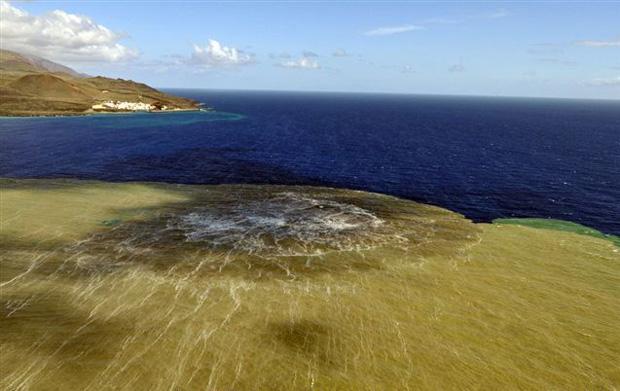In Spain’s Canary Islands, an underwater volcano excites, frightens
An underwater volcano off El Hierro is erupting. The green area comprises a dead zone where fish and humans cannot go. It’s frightened tourists away. (Photo courtesy of Spanish authorities.)
An undersea volcano erupting just south of Spain’s Canary Islands may be the beginnings of a new island, or an extension to an existing one.
For some, it’s a colorful spectacle – for others a major blow to their livelihood.
“It’s angry today. Look at it go!” said fisherman Elio Morales Rodriguez in the village of La Restinga, on the south coast of El Hierro island.
“That green patch on the water is a dead zone,” he said, looking out to sea. “It kills everything. No fishing, no dive schools, no tourists, just dead fish on the surface.”
For more than a month, the underwater volcano has been erupting three miles to the south of El Hierro, the smallest of the seven Canary Islands, about 50km (30 miles) south-west of its nearest neighbor, La Gomera, and 100km (60 miles) from the most populous of the islands – Tenerife.
From about 200 feet below the sea, the so-called “submarine” volcano is spewing gases and burning lava, some of which is breaking the surface of the water.
That has drawn lots of camera crews racing to the island to see what’s going on, but far fewer tourists than usual. Local journalist Barbara Belt said the islanders don’t know when all the fuss will die down and they will again be able to get on with their lives.
In the coastal village of La Restinga, many bars, restaurants and hotels are shut. Many of the village’s residents have already left.
Scientists say the eruption is part of the long-term volcanic evolution of the Canary Islands, which may result in a new island, or add new territory to the southern coast of El Hierro.
There is seismic activity to the north of the island too.
“There has been an enormous amount of seismic activity around the island,” said Nemesio Perez, scientific coordinator at Involcan, the Canaries Institute of Volcanology.
“Off the south coast, the magma has broken through the crust. The question is whether that will also happen off the north coast too.”
Mr Perez studied volcanology in Japan and the United States before returning to his native Canary Islands in 1997 to help improve the archipelago’s volcano monitoring network.
In the past four months, the network has detected more than 11,000 tremors across El Hierro island, one of which measured 4.6 on the Richter scale, and was strong enough to be felt on La Gomera and Tenerife. One resident of El Hierro said it was like an “energy jolt,” while another described the noise as “a deep roar.”
Most of the tremors on El Hierro have gone unnoticed by the 10,000 residents, but a few have been powerful enough to make some a little nervous.
“Islanders have had suitcases ready by the door, with a change of clothes, battery radio, torch, blanket and emergency rations,” Belt said.
On the north of the island, in an area called La Frontera, a teacher named Carmen said she’s using games to encourage children at her infant school to follow emergency procedures.
“When I blow a whistle, they scramble to get under the tables as fast as they can. We sing songs until the all-clear, then line up holding a rope to go outside,” she said.
“Islanders are told to stay inside during tremors,” Belt said. “When calm returns, they move outside to prearranged meeting points.”
The island got a visit from the Spanish defense minister in September.
In La Caleta, a civil defense task force has arrived from the Spanish mainland and is on stand-by to help in case of emergency.
The islanders’ daily lives were disturbed by the temporary closing of a vital road tunnel. There have also been evacuations from homes in potentially hazardous areas.
For some, the worst of it has been the impact on the tourist trade.
“The TV and papers dramatise everything,” said Maximo Rodriguez, chatting in a near-empty bar in La Restinga. “It scares people off. People should come. How often do you get the chance to witness this?”
On the north side of the island, in La Frontera, the owners of the Tasca La Cantina bar, Jose Antonio Padron Perez and his wife Maria Fonte Armas, say they are similarly fed up.
“We get walking groups from northern Europe throughout the winter season. Everyone cancelled. But real life isn’t as dramatic as the press says. We are all aware of volcanic activity. These are volcanic islands!” he said.
El Hierro has more than 500 open-sky cones, making it the most volcanic of all the Canary Islands, and this may be why so many Herrenos say they are unperturbed. Carmen said her children’s paintings of volcanoes are colorful and fun, not dark and sinister.
Joachim Gottsmann, a volcanologist at Bristol University in the United Kingdom, who leads a European Commission-funded volcano study, said there is no obvious or impending prospect of an Iceland-style “ash cloud” developing in the Canaries.
“Right now, the eruption south of El Hierro is really a submarine eruption only,” he said.
But that could change at any minute, he said.
So a cloud of uncertainty does hang over the heads of the islanders. They would like the fuss to subside – or at least for more tourists to come to the island to witness volcanic evolution for themselves.
